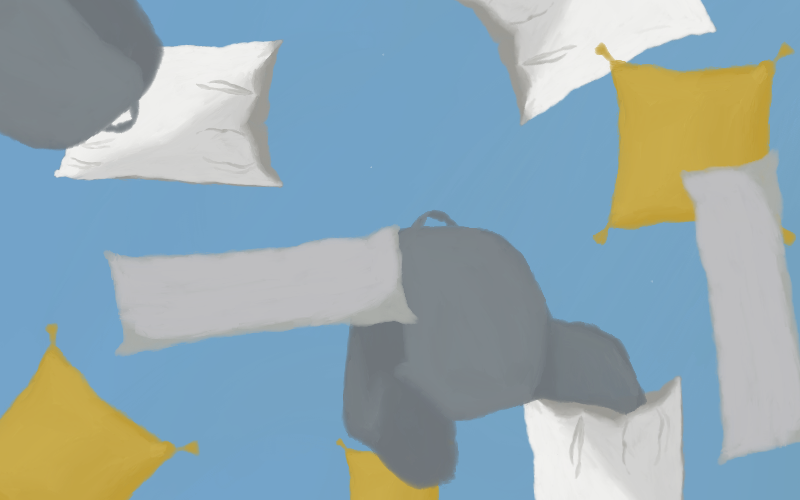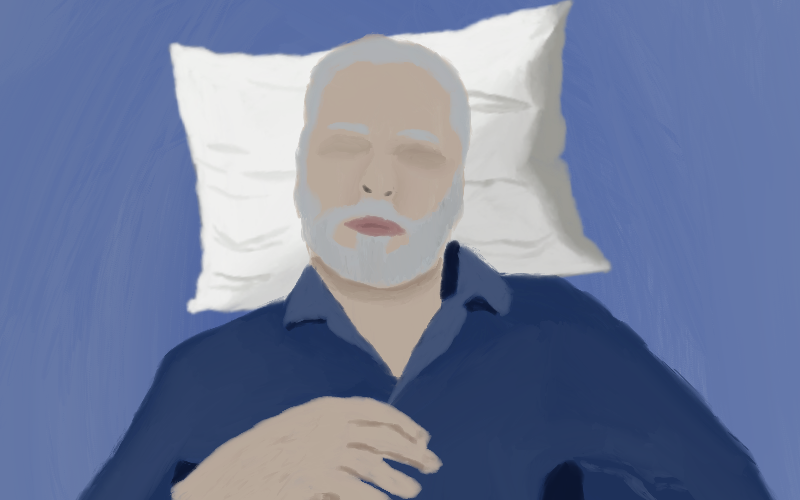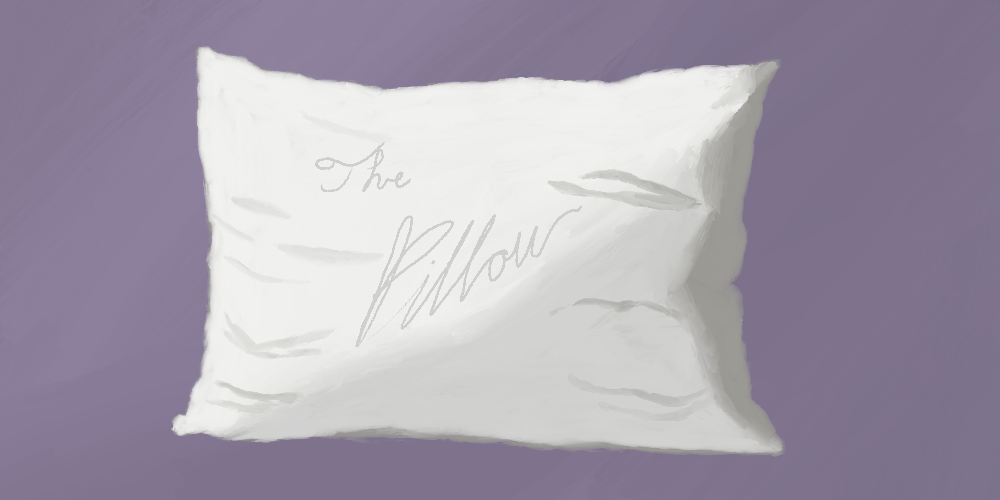This is part of a larger series about objects from a course taught by Marek Makowski, whose essay “Who Are the Writers Now?” kicked off this series. Amanda Crummy’s essay, “Handle with MMA Gloves” was the first in this series. Chikere Oduocha’s “His Hands” was the second. Emma Duffing’s is the final essay in this series.
The pillow, in its most basic form, is white, rectangular, and sits at the head of a bed. Usually sheathed in cases, pillows are vital in almost everyone’s sleep habits. The pillow’s stuffing enables a thickness suitable to elevate the head but also a softness that prevents the neck from lying at an awkward angle. Pillowcases may be seen as unnecessary to some, but their purpose is to preserve the pillow and keep it free from stains. These silk or cotton covers also allow each person to customize where they lay their head at night. During the day, when not in use, the pillowcase allows the pillow to become a decorative object.
The stuffing of a pillow greatly affects a person’s comfort. Feather-filled pillows have a firm feel for a more rigid headrest. Cheaper pillows use cotton and polyester filling for a softer, flatter cushion. Memory foam pillows form to the shape of one’s head. Down pillows feel plush, delicate, and luxurious. Every person is different when it comes to what type of stuffing best suits their body’s needs. Though these stuffings are mass-produced, they conform differently to each person who uses them.
Pillows also come in a plethora of varieties, and each kind differs in functionality. For example, a body pillow is normally twice, sometimes triple the length of a normal pillow. People use them to either lay their heads on them or hug them as if there were a person next to them. A pregnancy pillow, usually twice the length of your body, helps support the growing curves a woman’s body experiences during pregnancy. It allows pregnant women to stay asleep for longer periods of time and sleep in the positions that they used to. People primarily use neck pillows on airplanes or long car rides. The neck pillow makes it possible to sleep sitting up by supporting the head and protecting the neck from uncomfortable sleeping angles. All these pillows have many differences, but the main function for all of them is the same: comfort.

These different pillows and stuffings have to do with physical comfort, but pillows can offer emotional comfort, too. People feel this with their own pillow because every night when they sleep, they are at their most vulnerable. Why do they feel a deeper connection to their pillow? Much like a pacifier to a baby, or a blankie to a toddler, a pillow represents a calmness that they can only feel when we lay on it. Their pillow makes them feel safe enough to close their eyes and float into a state of unconsciousness. Because of this, even when they awaken, they still feel a connection of some sort to their pillow. If they are tired, a pillow is used to put them to sleep. If they are angry, they may use a pillow as a punching bag or scream into it. Afterward, the cushion absorbs the punches or shouts, the adrenaline will start to wear off, and they will start to calm down and maybe even lay their heads on that pillow. If they are sad, they may use the pillow to rest their face on it and cry. When they wake up in the morning for work or school, they may feel a longing for the safety of sleep for the comfort that their pillow brings them.
When I was little, about eight years old, I found comfort in body pillows. Sleeping next to one made me feel safe: no monsters could get to me while I slept. After my parents bought me my first body pillow, I decided I wanted more so that I could build a fortress in my bed and hide from all the unknown evils lurking in the shadows of my room. My grandparents thought the idea of little Emma surrounded by pillows taller than her was hilarious, so they bought me two more. My armor was finally complete.
My grandpa wanted to see what sleeping with a body pillow was like, so he decided to get one for himself. However, my grandma wouldn’t let him. Sharing a bed with one person can be hard, let alone with a four-foot pillow. Eventually, he understood her reasoning and settled on getting a mini pillow instead. The irony of a grown man getting a mini pillow while his young granddaughter got three body pillows was hysterical to him, and because of this he started to call his little pillow his “Emma Pillow.”
I was fourteen when my grandparents decided to move to Florida for the winters. I had gotten over my body pillow phase and was back to sleeping with one standard-sized pillow, but my Grandpa Frank still held onto his Emma Pillow. He had grown attached to the pillow over the years because it brought him comfort. I may never know how exactly a pillow barely the size of his head could bring him comfort, but everyone was aware that it did. The Emma Pillow traveled wherever Grandpa Frank traveled, so, when they decided to buy a house in Florida, the Emma Pillow spent its winters in sunny Punta Gorda with them.

I was also fourteen when my grandfather was diagnosed with cancer. Since they moved to Florida for half the year, I didn’t get to see him as much as I had used to, which was hard for me because I knew he was suffering. The only thing that kept me from breaking down sometimes was the fact that I knew his Emma Pillow was with him. In a way, the Emma Pillow brought me comfort, even though I was in another state, because I knew it comforted Grandpa Frank. He had his good days and bad days, like most cancer patients. On one of the bad days, my grandpa had to go to the hospital, and once he got there he realized he forgot something, the Emma Pillow. He made Grandma get back in the car, drive home, and bring the little pillow back to him.
I was at a friend’s house when I got the text that Grandpa Frank had passed away. I had never lost someone close to me before, so there was a new sinking feeling in my heart when I heard the news. It had been a few days since he passed, and I still didn’t feel like myself. My eyes seemed to be constantly filled with tears and there was a constricting in my throat that would not go away. After the funeral, I came back to my grandparents’ house, walked right to the room I stayed in, and cried. The pillows in the bed did little to comfort me because there wasn’t anything special about them, and they weren’t mine, there was no connection. As I laid there crying, my grandma quietly opened the door holding something. She didn’t say anything, just placed the Emma Pillow in my arms and walked back out the door. Although the pillow did nothing to bring back my grandfather, at least the worn-out pillowcase soaked up my tears. •




